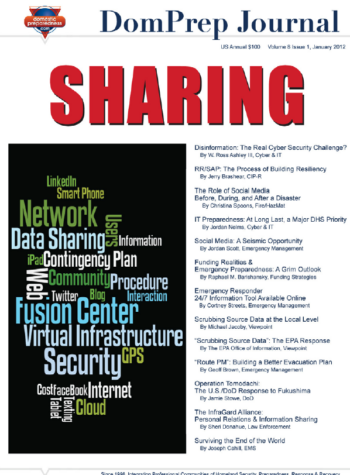
Operation Tomodachi: The U.S./DoD Response to Fukushima
Jamie Stowe
January 25, 2012
When Japan was faced with a Level-7 radiation event following the 2011 earthquake that triggered a devastating tsunami, it drew attention from agencies and governments around the world. The Tomodachi response team was deployed by the U.S. DoD to join Japanese forces in sharing radiation-related information to help contain the Fukushima radiation leaks. The above-and-beyond efforts of all involved provide valuable lessons learned for future events.

The InfraGard Alliance: Personal Relations & Information Sharing
Sheri Donahue
January 25, 2012
When the most capable and most experienced U.S. law-enforcement agency and 47,000 of the nation’s best informed and most dedicated private citizens join forces to thwart terrorists, track down and capture criminals, and protect the nation’s infrastructure, the smart money is on the “good guys”. Which is only one reason InfraGard has been such a success.

Surviving the End of the World
Joseph Cahill
January 25, 2012
In almost all dangerous events and incidents, the highest priority of the first responders on the scene is to save lives. The parallel obligation of emergency managers and other senior officials, therefore, is to do as much as possible to save and protect the lives of the lifesavers themselves.

RR/SAP: The Process of Building Resiliency
Jerry P. Brashear
January 25, 2012
Numerous tangible “things” and a broad spectrum of managers and operational personnel are needed to create and improve the nation’s physical resilience and recovery capabilities. The process starts, though, in the think tanks and sometimes esoteric planning sessions that determine what specific actions should be taken – when, how, and in what order – and what complications, costs, and conceptual considerations are likely to be involved.

Disinformation: The Real Cyber Security Challenge
W. Ross Ashley
January 25, 2012
U.S. intelligence experts and analysts are in general agreement that the protection of highly classified information is not only a “gentlemanly” goal, but also vital to the nation’s survival. However, the quality and accuracy of that information also needs to be protected, particularly in an age when there is a massive daily flow of data and content to cope with … and a tidal wave of communication that is false, malicious, and misleading as well.

'Route PM': Building a Better Evacuation Plan
Geoff Brown
January 18, 2012
One of the most difficult tasks facing emergency planners today involves traffic management – more specifically, getting as many people out of town just as fast as possible in times of crisis. That job is much more difficult when thousands of local residents head south instead of north – which is precisely why a new “dynamic time clearance calculator” is now one of the most essential tools of the trade.

'Scrubbing Source Data': The EPA Response
EPA Office of Information
January 18, 2012
Thank you for the opportunity to comment on the article being prepared for publication in the DomPrep Journal by Mr. Jacoby. That article, “Scrubbing Source Data at the Local Level,” raises a

Scrubbing Source Data at the Local Level
Michael Jacoby
January 18, 2012
First responders and private citizens are the first line of defense, particularly in their local communities, in times of crisis or need. Ensuring that those people, particularly, and local response

2012 Great Central U.S. ShakeOut
Domestic Preparedness
January 17, 2012
On 7 February 2012, more than one million people across nine states will participate in the 2012
Great Central U.S. ShakeOut! Learn more and/or sign up today to participate.

Integrating Emergency Management Education Into HSI Disciplines
Domestic Preparedness
January 13, 2012
This two-day course is targeted for Hispanic-Serving Institutions (HSI) Department Chairs of such EM-related disciplines as sociology, geography, public administration, and/or psychology. The primary goal of the workshop is to assist HSIs by providing helpful information about EM and the benefits and resources available for integrating EM course offerings into their curricula.






